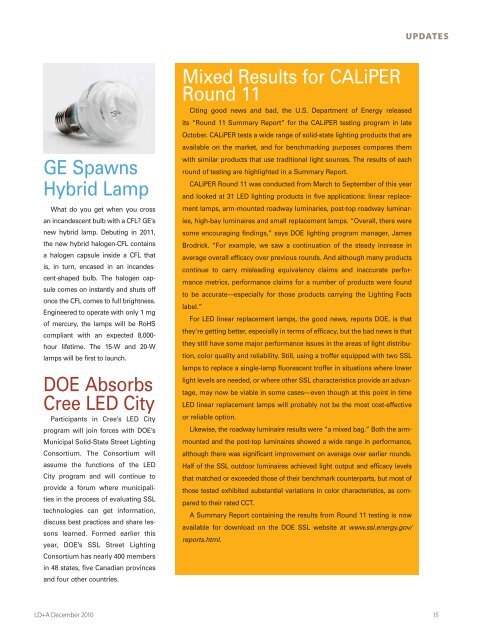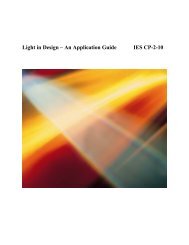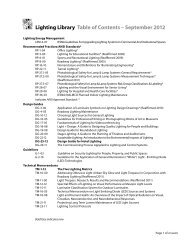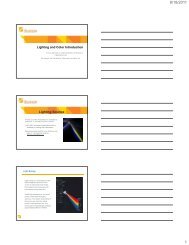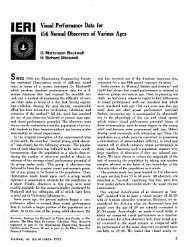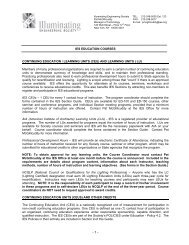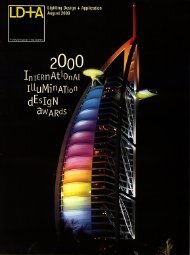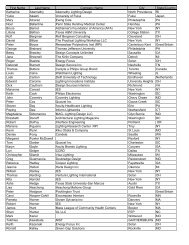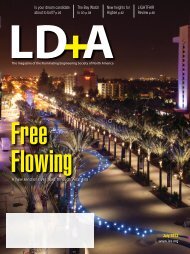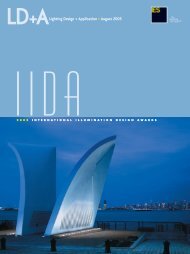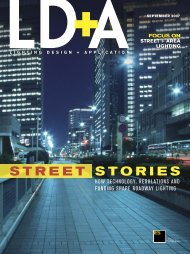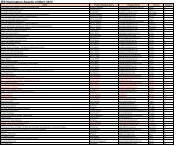faces of the future - Illuminating Engineering Society
faces of the future - Illuminating Engineering Society
faces of the future - Illuminating Engineering Society
Create successful ePaper yourself
Turn your PDF publications into a flip-book with our unique Google optimized e-Paper software.
UPDATES<br />
GE Spawns<br />
Hybrid Lamp<br />
What do you get when you cross<br />
an incandescent bulb with a CFL GE’s<br />
new hybrid lamp. Debuting in 2011,<br />
<strong>the</strong> new hybrid halogen-CFL contains<br />
a halogen capsule inside a CFL that<br />
is, in turn, encased in an incandescent-shaped<br />
bulb. The halogen capsule<br />
comes on instantly and shuts <strong>of</strong>f<br />
once <strong>the</strong> CFL comes to full brightness.<br />
Engineered to operate with only 1 mg<br />
<strong>of</strong> mercury, <strong>the</strong> lamps will be RoHS<br />
compliant with an expected 8,000-<br />
hour lifetime. The 15-W and 20-W<br />
lamps will be first to launch.<br />
DOE Absorbs<br />
Cree LED City<br />
Participants in Cree’s LED City<br />
program will join forces with DOE’s<br />
Municipal Solid-State Street Lighting<br />
Consortium. The Consortium will<br />
assume <strong>the</strong> functions <strong>of</strong> <strong>the</strong> LED<br />
City program and will continue to<br />
provide a forum where municipalities<br />
in <strong>the</strong> process <strong>of</strong> evaluating SSL<br />
technologies can get information,<br />
discuss best practices and share lessons<br />
learned. Formed earlier this<br />
year, DOE’s SSL Street Lighting<br />
Consortium has nearly 400 members<br />
in 48 states, five Canadian provinces<br />
and four o<strong>the</strong>r countries.<br />
Mixed Results for CALiPER<br />
Round 11<br />
Citing good news and bad, <strong>the</strong> U.S. Department <strong>of</strong> Energy released<br />
its “Round 11 Summary Report” for <strong>the</strong> CALiPER testing program in late<br />
October. CALiPER tests a wide range <strong>of</strong> solid-state lighting products that are<br />
available on <strong>the</strong> market, and for benchmarking purposes compares <strong>the</strong>m<br />
with similar products that use traditional light sources. The results <strong>of</strong> each<br />
round <strong>of</strong> testing are highlighted in a Summary Report.<br />
CALiPER Round 11 was conducted from March to September <strong>of</strong> this year<br />
and looked at 31 LED lighting products in five applications: linear replacement<br />
lamps, arm-mounted roadway luminaries, post-top roadway luminaries,<br />
high-bay luminaires and small replacement lamps. “Overall, <strong>the</strong>re were<br />
some encouraging findings,” says DOE lighting program manager, James<br />
Brodrick. “For example, we saw a continuation <strong>of</strong> <strong>the</strong> steady increase in<br />
average overall efficacy over previous rounds. And although many products<br />
continue to carry misleading equivalency claims and inaccurate performance<br />
metrics, performance claims for a number <strong>of</strong> products were found<br />
to be accurate—especially for those products carrying <strong>the</strong> Lighting Facts<br />
label.”<br />
For LED linear replacement lamps, <strong>the</strong> good news, reports DOE, is that<br />
<strong>the</strong>y’re getting better, especially in terms <strong>of</strong> efficacy, but <strong>the</strong> bad news is that<br />
<strong>the</strong>y still have some major performance issues in <strong>the</strong> areas <strong>of</strong> light distribution,<br />
color quality and reliability. Still, using a tr<strong>of</strong>fer equipped with two SSL<br />
lamps to replace a single-lamp fluorescent tr<strong>of</strong>fer in situations where lower<br />
light levels are needed, or where o<strong>the</strong>r SSL characteristics provide an advantage,<br />
may now be viable in some cases—even though at this point in time<br />
LED linear replacement lamps will probably not be <strong>the</strong> most cost-effective<br />
or reliable option.<br />
Likewise, <strong>the</strong> roadway luminaire results were “a mixed bag.” Both <strong>the</strong> armmounted<br />
and <strong>the</strong> post-top luminaires showed a wide range in performance,<br />
although <strong>the</strong>re was significant improvement on average over earlier rounds.<br />
Half <strong>of</strong> <strong>the</strong> SSL outdoor luminaires achieved light output and efficacy levels<br />
that matched or exceeded those <strong>of</strong> <strong>the</strong>ir benchmark counterparts, but most <strong>of</strong><br />
those tested exhibited substantial variations in color characteristics, as compared<br />
to <strong>the</strong>ir rated CCT.<br />
A Summary Report containing <strong>the</strong> results from Round 11 testing is now<br />
available for download on <strong>the</strong> DOE SSL website at www.ssl.energy.gov/<br />
reports.html.<br />
LD+A December 2010 15


